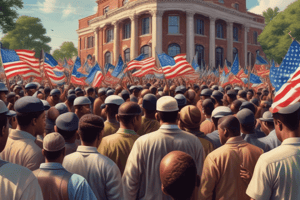Podcast
Questions and Answers
Which of the following options correctly identifies a primary similarity in the motivations of marchers like Sheldon Steinhauser and Lynda Blackmon Lowery during the 1965 march to Montgomery?
Which of the following options correctly identifies a primary similarity in the motivations of marchers like Sheldon Steinhauser and Lynda Blackmon Lowery during the 1965 march to Montgomery?
- Both aimed to improve educational infrastructure and access to quality schooling for African Americans.
- Both were focused on gaining political office and increasing representation in government.
- Both were driven by a fundamental desire for racial equality and an end to discriminatory practices. (correct)
- Both were primarily motivated by seeking economic opportunities and job creation in the South.
Considering that Lynda Blackmon Lowery was a local Alabaman and Sheldon Steinhauser traveled from out of state, which statement best describes a key difference in their likely perspectives or experiences during the 1965 march to Montgomery?
Considering that Lynda Blackmon Lowery was a local Alabaman and Sheldon Steinhauser traveled from out of state, which statement best describes a key difference in their likely perspectives or experiences during the 1965 march to Montgomery?
- Lynda Blackmon Lowery was primarily focused on influencing national policy, whereas Sheldon Steinhauser was more interested in immediate local changes.
- Lynda Blackmon Lowery likely had deeper, firsthand experience with local segregation and its impact, while Sheldon Steinhauser may have had a broader, more theoretical understanding. (correct)
- Sheldon Steinhauser likely faced greater economic hardship due to travel costs, while Lynda Blackmon Lowery was more concerned with immediate dangers.
- Sheldon Steinhauser likely received more support from national civil rights organizations, while Lynda Blackmon Lowery relied solely on local community resources.
How might the difference in age and background between Lynda Blackmon Lowery, a young local participant, and Sheldon Steinhauser, an older out-of-state activist, have affected their roles or contributions during the march?
How might the difference in age and background between Lynda Blackmon Lowery, a young local participant, and Sheldon Steinhauser, an older out-of-state activist, have affected their roles or contributions during the march?
- Lynda Blackmon Lowery's youth likely made fundraising easier, while Sheldon Steinhauser's activism brought legal expertise to the march.
- Lynda Blackmon Lowery's local ties likely facilitated community organizing, while Sheldon Steinhauser's experience may have offered strategic planning insights. (correct)
- Lynda Blackmon Lowery's youth limited participation to administrative tasks, while Sheldon Steinhauser led confrontations and protests.
- Lynda Blackmon Lowery's activism focused soley on media outreach, while Sheldon Steinhauser managed logistics and supplies.
Considering that Steinhauser was from out of state while Lowery was from the local area, what could have been a potential challenge Steinhauser faced that Lowery may not have encountered during the march to Montgomery?
Considering that Steinhauser was from out of state while Lowery was from the local area, what could have been a potential challenge Steinhauser faced that Lowery may not have encountered during the march to Montgomery?
In comparing the motivations of marchers like Steinhauser and Lowery, which aspect most likely reflects a universal goal shared by all participants, regardless of their background?
In comparing the motivations of marchers like Steinhauser and Lowery, which aspect most likely reflects a universal goal shared by all participants, regardless of their background?
Flashcards
Sheldon Steinhauser's Motivation
Sheldon Steinhauser's Motivation
Sheldon Steinhauser marched for Civil Rights, driven by a belief in justice and equality, stemming from his Jewish faith and experiences with discrimination.
Lynda Blackmon Lowery's Motivation
Lynda Blackmon Lowery's Motivation
Lynda Blackmon Lowery, a local Black teenager, marched to end segregation and gain voting rights, fueled by firsthand experience of racial injustice in Alabama.
Shared Motivation
Shared Motivation
Both were motivated by a desire to end racial inequality and secure equal rights for African Americans during the Civil Rights Movement.
Difference in Motivation Source
Difference in Motivation Source
Signup and view all the flashcards
Background Influences
Background Influences
Signup and view all the flashcards
Study Notes
- Sheldon Steinhauser and Lynda Blackmon Lowery both participated in the march to Montgomery on March 25, 1965.
Similarities in Motivation
- Both Steinhauser and Lowery were driven by a desire to fight for civil rights and racial equality.
- Both were motivated by the injustices and discrimination faced by African Americans in the South.
- Both felt a sense of moral obligation to participate in the movement and challenge the status quo.
Differences in Motivation
- Steinhauser, being white, might have been motivated by a sense of solidarity and a desire to dismantle systemic racism from a perspective of privilege.
- Lowery, being Black and having directly experienced the effects of segregation and discrimination, was motivated by the urgent need for personal and community liberation.
- Steinhauser's involvement might have stemmed from a more intellectual or ideological commitment to equality.
- Lowery's involvement might have been more deeply rooted in her personal experiences and the struggles of her community.
Studying That Suits You
Use AI to generate personalized quizzes and flashcards to suit your learning preferences.




